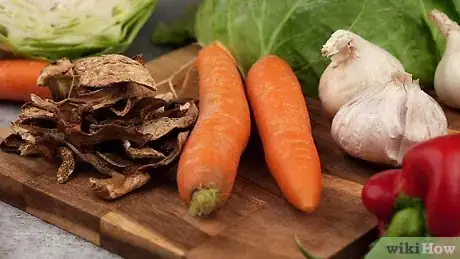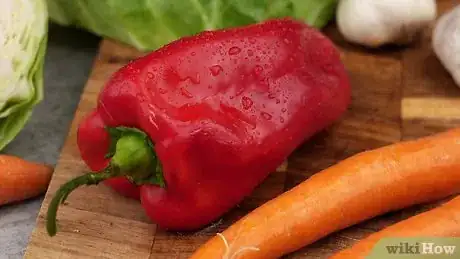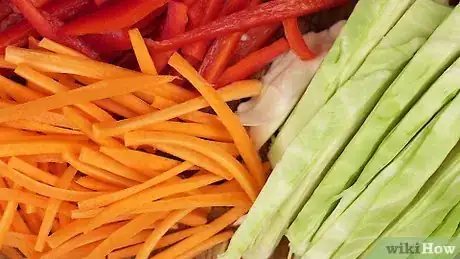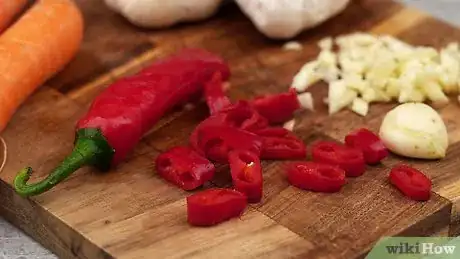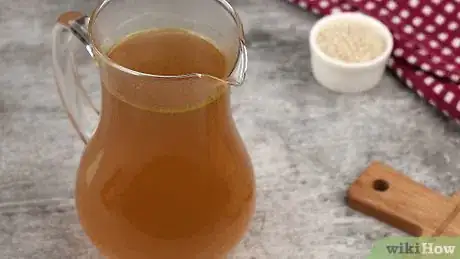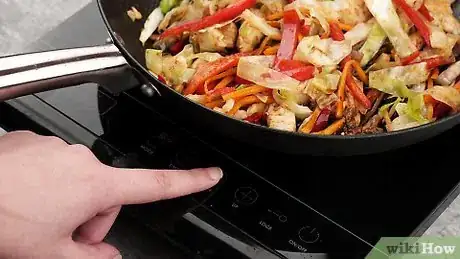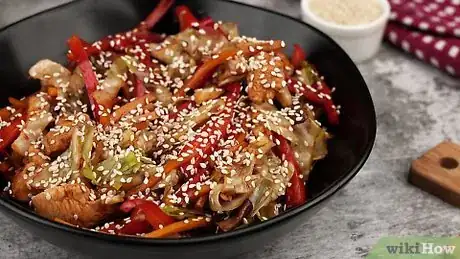This article was co-authored by JoAnna Minneci. JoAnna Minneci is a Professional Chef based in the Nashville, Tennessee area. With more than 18 years of experience, Chef JoAnna specializes in teaching others how to cook through private cooking lessons, team-building events, and wellness and nutrition classes. She has also appeared in numerous television shows on networks such as Bravo and Food Network. Chef JoAnna received Culinary Arts training from the Art Institute of California at Los Angeles. She is also certified in sanitation, nutrition, kitchen management, and cost control.
wikiHow marks an article as reader-approved once it receives enough positive feedback. In this case, 100% of readers who voted found the article helpful, earning it our reader-approved status.
This article has been viewed 196,000 times.
Stir frying is a quick and tasty to prepare a well-balanced meal. As long as you have a skillet or wok and the right kind of oil, you can experiment with any combination of vegetables. Add tofu, chicken, beef or another protein if you'd like. To season the stir fry, you can mix in a sauce or blend of spices. If you want to learn how to make a crunchy, satisfying stir fry, see Step 1.
Steps
Preparing the Ingredients
-
1Select vegetables to use. Almost any combination of vegetables can be used in a stir fry. Aim to include a variety of colors and textures, plus one or more especially flavorful, aromatic ingredients. Either fresh or frozen vegetables work well in stir fries, but avoid using canned vegetables, since they'll throw off the texture of your stir fry. Aim to prepare one and a half cups of any combination of fresh vegetables per serving of stir fry. Try using all of the following ingredients that you enjoy, and add any favorites that aren't listed:
- Bell peppers
- Snap peas
- Carrots
- Water chestnuts
- Green or red cabbage
- Broccoli, or broccoli rabe
- Eggplant
- Onions
- Shiitake mushrooms
- Pre-cooked raw bamboo shoots.
-
2Wash and dry the vegetables. Fresh vegetables should be rinsed before using them in recipes, while cans of vegetables should be drained of water. Pat them dry with paper towels or a clean dishcloth to make sure they cook correctly. Wet vegetables will steam instead of frying, resulting in a soggy texture.
- Frozen vegetables do not need to be thawed if they are already in small pieces, but it's a good idea to rinse off the ice crystals and then pat them dry to keep the stir fry as dry as possible.[1]
Advertisement -
3Slice the vegetables into thin pieces. In a stir fry, the key is to be able to cook all of the ingredients quickly and evenly, so each piece is ready at the same time. The size and thickness of the vegetable pieces will plays a large part in making sure each piece is fully cooked but not overdone. As a general rule, your vegetables will cook more consistently and quickly if cut into thin slices.
- As you prep the vegetables, keep each type separate. Since some vegetables cook more quickly than others, you'll be adding them to the wok at different times.
- For vegetables that tend to cook more slowly, cut them into slightly smaller pieces so they aren't undercooked when everything else is ready. For example, potatoes, carrots, and other starchier vegetables tend to need more time than mushrooms and eggplant.
-
4Prepare aromatic seasonings. Garlic, ginger, chili peppers, and scallions add depth to the flavor of stir fry dishes. A small amount of any of these ingredients goes a long way. Be sure to peel garlic, ginger or onions before adding them to your stir fry.
- Chop aromatic seasonings into the smallest pieces you can, so that their flavor is evenly distributed throughout the stir fry.
- For a two-person stir fry, try one clove of garlic, one or two chopped scallions, 1⁄2 inch (1.3 cm) of fresh chopped ginger, and one small minced chili pepper.[2]
-
5Prepare a protein. Stir fried vegetables taste great on their own, but if you want your meal to contain some protein, consider adding tofu, chicken, beef, pork, or another type of meat. To prepare your protein for the stir fry, do the following:
- Chop meat into thin, bite-sized pieces. Thicker pieces of meat won't cook quickly enough. It's important to make sure everything gets cooked thoroughly if you're adding meat to your stir fry.
- Chop tofu into bite-sized chunks. Choose firm tofu that will hold up to frying. Silken tofu breaks down easily and won't hold up in a stir fry.
Choosing a Sauce
-
1Buy or make teriyaki sauce. This tangy, sweet sauce is often used to flavor stir fries. You can buy a bottle of teriyaki sauce or mix up your own. This method for making teriyaki sauce makes enough to flavor two servings of stir fry:
- Combine 1/2 cup soy sauce, 1/4 cup water, 1 tablespoon rice wine, and 2 tablespoons brown sugar in a saucepan.
- Heat the mixture and allow it to simmer until it begins to thicken and the sugar is completely dissolved.
- Add salt and red pepper flakes to taste.
-
2Mix white wine and soy sauce. This is a simple, dead-easy sauce for stir fry that kicks it up a notch. All you need is some white wine and soy sauce. A few spoonfuls each of these two ingredients is a simple, tasty option. Dry sherry (not sweet) can also be used in place of white wine. Add salt and red pepper flakes to taste.
-
3Make your own peanut sauce. Peanut sauce adds a significantly different flavor than other traditional sauces. It's a popular restaurant option that can be made on your own with surprising ease. To make peanut sauce, do the following:
- Combine 1/2 cup creamy peanut butter, 2 tablespoons water, 1 tablespoon lime juice, 1 tablespoon soy sauce, and 1 teaspoon brown sugar.
- Add a clove of minced garlic, a few shakes of sesame oil, or red pepper flakes to enhance the flavor.
- Let the mixture rest in the refrigerator overnight so the flavors have time to meld.
-
4Use broth to flavor your stir fry. For a milder taste, use vegetable, chicken, or beef broth to flavor the stir fry. Consider mixing it with soy sauce to the strength you enjoy, then flavoring with savory herbs and spices.[3]
- Mix in a teaspoon of sugar and one of rice wine vinegar for a more traditional taste.
- Mix equal parts lemon juice and broth for a tart taste.
Cooking the Stir Fry
-
1Heat a wok or skillet over high heat. Don't add the oil yet; just heat your cooking implement. If you don't have a wok, use a heavy skillet with high sides. This type of skillet will keep the vegetables hot and let you stir them without spilling.
- Do not let the wok or skillet overheat, or you could start a fire when you add the oil. The wok or skillet is ready when a drop of water vaporizes within 2 seconds.[4]
- Open any windows and turn on the oven fan if you have one. Stir frying can produce a lot of smoke and heat.
-
2Add two or three tablespoons of oil. Ideally, you should use an oil that can be heated to very high temperatures before it starts smoking. Peanut, canola, corn, safflower, and rice bran oil are all good choices. Don't use extra virgin olive oil, sesame oil, or butter, since these will smoke too quickly in the high heat.[5]
- Hold the handle of the skillet or wok and rotate it so the oil coats the whole surface. It should break apart into a chain of oil beads and easily run across the bottom of the pan.
- If the oil is slow to spread, the skillet or wok probably isn't hot enough. Heat it until the oil is drippy before you start adding ingredients. Otherwise, the stir fry could come out soggy.
-
3Stir in the aromatics when the oil begins to shimmer. The oil will begin to shimmer shortly before it smokes. That shimmer tells you the ideal time to add the first ingredients. If you don't catch the shimmer, add the ingredients when the oil starts to smoke a little. Now is the time to add garlic, ginger, scallions, and chili peppers, which will flavor the oil in preparation for the vegetables and protein.
- Use a wooden spoon to quickly stir the ingredients, or toss them in the oil if you can do it without spilling anything.
- Cook the aromatics for about 30 seconds before moving on to the vegetables and protein. Don't wait too long, since garlic and other aromatics burn easily in a hot wok.
-
4Stir in the ingredients with long cooking times. Besides proteins like tofu or meat, now is the time to add hard, dense vegetables like potatoes, broccoli, cauliflower, squash, and string beans.[6] Stir the ingredients quickly with a wooden spoon, or toss them with tongs.
- To avoid making the stir fry soggy and unevenly cooked, only use enough vegetables to cover the base of the wok or skillet. Since a stir fry only takes a few minutes, you could cook your vegetables in batches, letting the wok and oil warm up in between.
- If the ingredients seem to be overcooking, stir more vigorously instead of turning down the heat. This keeps vegetables hot and dry, which results in proper stir fry cooking.
- Continue cooking the meat and denser vegetables until the meat is mostly cooked and the vegetables have become bright and slightly soft. This should take anywhere from 3 to 10 minutes, depending on the exact ingredients you're using.
-
5Add the vegetables with shorter cooking times. Once the bulkier ingredients are mostly finished cooking, add the vegetables that don't need much time to cook. Keep stirring vigorously as you add the remaining vegetables.
- Vegetables to add at this point include bok choy, bell peppers, and mushrooms.
- Ingredients that take even less time include zucchini, shredded cabbage, snap peas, and leafy greens.[7] These can be added at the same time for simplicity, or you can wait until the other vegetables are nearly ready.
-
6When the vegetables are tender, add a few spoonfuls of sauce. Toss it in so that it coats all the other ingredients, then cook for an additional one to two minutes. Your stir fry should be nearly done after an additional 1–2 minutes.
- Pour the sauce in a line on the side of the skillet or wok, not the base, to keep the bottom of the wok hot.
- Don't use too much sauce, since it can make the vegetables too wet.
-
7Serve the stir fry immediately. It's texture is best hot off the wok. As soon as the sauce is on the vegetables, turn off the heat and transfer the food onto plates. The stir fry will be most delicious and tender right away, so don't let it get cold before eating. Steamed rice of any variety goes well with stir fry and soaks up the sauce nicely, but stir fries can also be delicious plain.
Playing with Texture and Flavor
-
1Adjust the cooking time if a vegetable is too mushy or crunchy. The size of the vegetable pieces, their variety and age, and your personal preference all dictate how long a vegetable should be cooked. Cooking several stir fries using your favorite vegetables will help you get a feel for how long each vegetable should stay in the wok.
- If you find a particular vegetable in the stir fry too crunchy, add it earlier next time.
- If a vegetable feels too soft or falls apart, add it later next time.
-
2Blanch or soak hard vegetables that take too long to cook. Carrots, cauliflower, and broccoli are often the culprits, since they are hard and can be difficult to cut into small pieces. If these or other tough vegetables take too long, you have a couple options:[8]
- Blanch them before frying. If your vegetable pieces are at least half an inch thick, steaming them for a short time will quickly make them softer. Always pat them dry before frying.
- Alternatively, add a small amount of water, broth, or dry sherry during the cooking. Cover for one to two minutes until the vegetables are tender, then continue stir frying as normal.
-
3Soak dried mushrooms in hot water before using. You'll need to soak dried mushrooms for five to fifteen minutes or until tender before you can use them in a stir fry.[9] Adding them dry will result in hard, chewy bits in your stir fry.
- To soak dried mushrooms, boil some water, then remove from heat and add the mushrooms. Remove them from the water once they're plump, after three to five minutes.
- Dried shiitake are harder than other varieties, so they may need to be soaked for up to 10 minutes.
-
4Experiment with garnishes. After the stir fry has been taken off the heat, you might want to add a flavorful decoration that doesn't require cooking in the wok or skillet. For that perfect final touch, here are a few good options:
- Sesame seeds or toasted nuts sprinkled over the stir fry add satisfying crunch.
- Parsley, basil, or other fresh herbs look attractive and add a pleasant scent.
- Sprinkle on a few thin slices of raw vegetables to add a brighter color and different consistency to the dish.
-
5Finished.
Community Q&A
-
QuestionCould I freeze this recipe and if so, how would be best?
 Community AnswerYes, you can put them in freezer bags for later use. Chop up and prepare the vegetables first.
Community AnswerYes, you can put them in freezer bags for later use. Chop up and prepare the vegetables first. -
QuestionIf I wanted to add rice. At what point would I do that?
 Community AnswerPre-cook the rice according to packet directions, drain, and then add it to the stir-fry just before you add the sauce (make sure the rice is warm before you add the sauce, if it's cool by the time you add it to the stir-fry).
Community AnswerPre-cook the rice according to packet directions, drain, and then add it to the stir-fry just before you add the sauce (make sure the rice is warm before you add the sauce, if it's cool by the time you add it to the stir-fry). -
QuestionI really don't like to freeze anything, I like everything fresh. Is that okay?
 Community AnswerThat's great! Use fresh ingredients of your choice for a great and healthy stir fry that tastes completely fresh.
Community AnswerThat's great! Use fresh ingredients of your choice for a great and healthy stir fry that tastes completely fresh.
Things You'll Need
- Wok (or a heavy, deep-sided skillet)
- Paper towels
- Wooden spoon
Warnings
- Use firm tofu, not silken tofu. The latter type will fall apart in a stir fry.⧼thumbs_response⧽
- Peanut oil, commonly used in stir fries, can cause serious harm to people with peanut allergies.⧼thumbs_response⧽
References
- ↑ http://www.wisegeek.com/what-are-the-best-tips-for-making-stir-fry-with-frozen-vegetables.htm
- ↑ http://www.jamieoliver.com/recipes/vegetables-recipes/stir-fried-vegetables
- ↑ http://allrecipes.com/howto/super-easy-stir-fry/
- ↑ http://consults.blogs.nytimes.com/2010/09/09/a-cook-talks-about-woks-and-stir-fries/
- ↑ http://consults.blogs.nytimes.com/2010/09/09/a-cook-talks-about-woks-and-stir-fries/
- ↑ http://www.dvo.com/newsletter/weekly/2012/06-08-876/how-long-to-cook-stirfry.html
- ↑ http://www.dvo.com/newsletter/weekly/2012/06-08-876/how-long-to-cook-stirfry.html
- ↑ http://consults.blogs.nytimes.com/2010/09/09/a-cook-talks-about-woks-and-stir-fries/
- ↑ http://www.nytimes.com/recipes/1014348/mushroom-stir-fry.html
About This Article
To stir fry vegetables, heat 2 to 3 tablespoons of oil until it begins to shimmer, then add the aromatics, like ginger, garlic, or shallots, and stir them while they cook them for about 30 seconds. Add in any vegetables or proteins that take awhile to cook, like meat, broccoli, or potatoes. When the meat is mostly cooked and the vegetables are slightly soft, add the vegetables that don’t need much time to cook, like bok choy, bell peppers, and mushrooms. When all of the vegetables are tender, stir in the sauce and let it cook for 1-2 minutes, then serve. For more tips, including how to choose a sauce that will pair well with your stir fry, read on!
